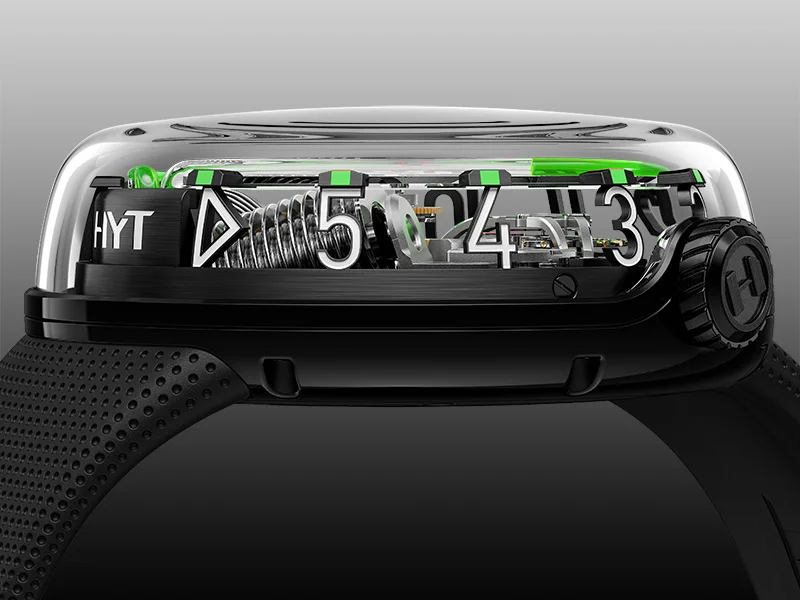HYT: New Horological Horizons
HYT uses open space and symmetry to emphasize the extraordinary depth of its new H20.
From the beginning, HYT’s primary motivation was to create a modern version of the clepsydra, an ancient clock that uses water to measure time. To succeed with this radical idea, the company would need to ignore one of mechanical watchmaking’s cardinal rules: water and watch movements don’t mix.
Despite centuries of watchmaking wisdom to the contrary, HYT was convinced it could overcome the significant technical challenges it faced through the right combination of determination and imagination. Those instincts were proven right in 2012 when HYT unleashed the first wave of watches from in its hydro-horological revolution. Since then, the company has established a tradition of making bold design choices, like the sleek profile of its new H0 collection, the captivating memento mori motif of its Skull watches, and the playful spirit reflected in the H4’s light-up movement.
Even among the dazzling denizens that make up the HYT collection, the new H20 models stand out. The minimalist look represents a dramatic evolution from the H2, its predecessor and one of the brand’s most-popular models.
Both H20 models — H20 Silver and H20 Black — will be made in a series limited to 25 pieces each.
ENDLESS VISTA
What’s immediately clear is the vast openness exposed by the H20’s design. Part of that can be attributed to the size of the case, which at is 51mm is more than 2mm wider than the H2. But it’s more than just additional space. The key to the H20’s airy look is a new domed, sapphire-crystal case. It floods the movement with light and opens up an entirely new lateral view of the complex movement. It’s as if architect Philip Johnson took his concept of the Glass House and applied it to watch case design.
The box domed sapphire crystal case measures 51mm across and is almost 20mm tall.
To create the H20, every design decision appears to have been made in an effort to maximize clarity and open space. Look no further than the numbers used for the hours. Typically, you would expect to see them circling the top of the dial. Instead, HYT shifts perspectives and places these perfectly machined numerals underneath the liquid hour display. Here, there’s enough space for the numbers to stretch out. Tall, thin and extremely legible, they’re exemplars of both form and function.
Diamond-cut numbers circle the dial underneath the liquid hour display.
The same visual logic is also applied to the hand-wound movement, which is laid out almost symmetrically to form a dynamic backdrop for the liquid display. The overarching aesthetic is industrial with components arranged to suggest a high-performance engine. Peering through a loupe at the gears stacked in the center of the dial, it’s easy to imagine a transmission in action. Likewise, the two reservoirs positioned at opposite ends of the liquid time display immediately call to mind a v-twin motorcycle engine. You can even see the energy generated by this horological engine at the top of the dial, where the balance wheel oscillates in a perpetual blur underneath an arched bridge.
The hand-wound movement has an eight-day power reserve.
KINETIC SCULPTURE
The advanced engineering needed to create the H20 certainly influenced the aesthetics, but its impact on the design obviously goes much deeper. In fact, it’s the common thread — tube actually — that connects every HYT watch.
Several years ago, HYT combined a mechanical watch movement with clever chemistry and fluid dynamics to create its modern take on the clepsydra, an ancient clock designed to measure time through the steady and predictable flow of water from one container to another. But instead of using terra cotta pots to hold the water, HYT uses two flexible metal-alloy reservoirs.
In the H20, those reservoirs form an acute angle at the 6 o’clock position. Each one is connected to a different end of a hollow tube that rises up to circle the dial. As hours pass, the watch movement uses a piston to apply pressure to the reservoir on the left, which in turn pushes colored fluid out into the tube. The opposite happens on the right side, where a second piston reduces pressure on the reservoir, allowing the transparent liquid to retreat from view.
At 6 o’clock, the colored fluid flows backward around the dial to its original position.
This mechanical process controls the fluid’s movement so precisely that it can be used to track the hour. But pistons and reservoirs can’t do it alone. HYT also had to create special fluids for the system. Because they repel each other on a molecular level, the clear and colored fluids will never mix. Instead, they form an intractable line where they meet. HYT uses this chemical reaction to create an artistic interpretation of the traditional hour hand.
It’s exciting to see what happens when the colored fluid completes its journey around the dial. At 6 o’clock, the colored liquid recedes as the clear fluid floods the tube. The process is meant to mimic the movement of a traditional retrograde-style hand as it snaps back to zero after completing a measurement.
No one had ever seen anything like HYT when it debuted. Six years later, there’s still nothing that compares. And with the H20, the hydro-mechanical masters at HYT embrace a new dimension in watchmaking.
<iframe width="560" height="315" src="https://www.youtube.com/embed/4Ur4rnNvpUU" frameborder="0" allow="autoplay; encrypted-media" allowfullscreen></iframe>
See more watch reports and reviews at Cellini Jewelers
Original article by Scott Hickey










